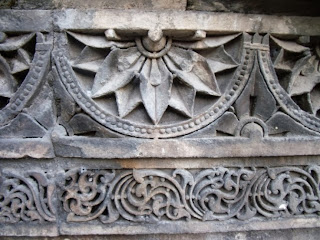From Adalaj, my next stop was Dada Harir ni Vav.
Unlike Adalaj which was located close to the town, Dada Harir ni Vav is tucked away in the little village called Asarwa. This was built in 1501 AD by Sultan Bai Harir.
Similar to the Sanskrit inscription in Adalaj, here too is a Sanskrit inscription on marble. Just opposite to it is an Arabic inscription on marble!
Unlike Adalaj, the steps here go east to west direction with walls on northern and southern sides, which also have spiraling steps that go from base to top. Though these are accessible here, they were filled with so many bats that made actually venturing into them, impossible!
The detailing of the sandstone relief sculptures was not that intricate as Adalaj, but this too was very intricate...
... and the well from atop!
On the wall of the well, hardly a few feet above the ground, I spotted this little relief. An 'OM' symbol made of fishes! Above that is a border design, very similar to the Patan Patola pattern!!!
Just behind the Vav was the Bai Harir Sultani Mosque.. Coming back soon with that!
Btw, I specifying so much about Adalaj. What's this Adalaj? That's coming up soon too!!! :)
TO GET THERE:
From Ahmedabad Airport: 7km via Airport Road, Narmada Shankar Road, Babu Jagjivan Ram Bridge, Amarsinh Chaudhary Bridge, and Hanuman Singh Road.
About 1/4 km on Hanuman Singh road, the main road automatically curves to the left and a little road goes straight. Within 200m Dada Harir Vav is located to the left. Its not very visible from the road, so look out for it carefully.
On Google Maps: http://goo.gl/maps/rv1FO
P.S: Thanks to Fly Tagged for this memorable trip!
Btw, I specifying so much about Adalaj. What's this Adalaj? That's coming up soon too!!! :)
TO GET THERE:
From Ahmedabad Airport: 7km via Airport Road, Narmada Shankar Road, Babu Jagjivan Ram Bridge, Amarsinh Chaudhary Bridge, and Hanuman Singh Road.
About 1/4 km on Hanuman Singh road, the main road automatically curves to the left and a little road goes straight. Within 200m Dada Harir Vav is located to the left. Its not very visible from the road, so look out for it carefully.
On Google Maps: http://goo.gl/maps/rv1FO
P.S: Thanks to Fly Tagged for this memorable trip!






















I don't think it was Om but looks more like a scorpion!
ReplyDeleteYeah, its a couple of scorpions. But together they look like OM. Was it intentional or not is a different story! :)
DeleteAlso, guess you've missed to mention the Kuvado (water source for cattle) and Mandaps :(
ReplyDeleteA lot is missed Ramjee, as usual. Many a times, covering every aspect of any historical monument proves to reveal a thesis full of matter!!!
DeleteThis is something!
ReplyDeleteIndeed. Prehaps the best stepwall if you want to understand the architecture aspect, as you can go anywhere and everywhere within it!!!
DeleteBeautiful place and inscripted marble.
ReplyDeleteGreetings
Rose
Thanks Rose! :)
DeleteTHank you for comment on my Blog, i follow you via Google +, GFC, and at home, my handy ist at home today :( on twitter ;) xoxo Babsi
ReplyDeleteThank you. Coming over! :)
DeleteA good take Adalaj! I wonder how painstakingly the inscriptions were carved, bit by bit... Any idea how much time it took? Planning for a visit to Gujarat next year....thanks at least know something about Gujarat other than its cuisine ....One question... might sound silly but why are the floors built inside the well ;)
ReplyDeleteThis is not Adalaj! This is Dada Harir ni Vav!!!
DeleteIndeed they're breath taking...
Gujarat is an arid region and conserving water was essential and its a part of their heritage since centuries...
That's why the demarcation between temple and water conservation, kind of merges here!!!
Similar to temples, we have floors, sculptures etc
Such brilliant works. Nice post.
ReplyDeleteThanks Niranjan!
Delete